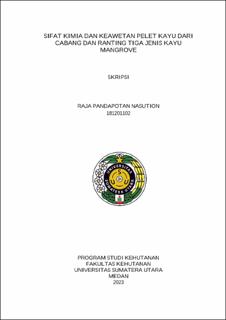Sifat Kimia dan Keawetan Pelet Kayu dari Cabang dan Ranting Tiga Jenis Kayu Mangrove
Chemical Properties and Durability of Wood Pellets from Branches and Twigs of Three Types of Mangrove Wood

Date
2023Author
Nasution, Raja Pandapotan
Advisor(s)
Nuryawan, Arif
Basyuni, Mohammad
Metadata
Show full item recordAbstract
Mangroves can be used as a source of income from ecotourism and recreation. Currently, the community around mangroves is accustomed to processing products "tangible" through community service activities. The purpose of this study was to see data and information on the chemical properties and durability of wood pellets from branches and twigs of 3 types of mangrove wood. The method of this study is to test 3 raw materials with ash levels, flying substance levels and termite durability testing. The results obtained on the wood pellets of the branches of 3 types of mangroves have ash levels with values in the type of mata buaya branches (B. sexangula) of 14.63% and in the type of bakau minyak branches (R. apiculata) which is 4.10%. While the wood pellets of the twigs of 3 types of mangroves obtained ash content test results on the type twigs of bakau minyak (R. apiculata) which was 18.70% and on the type twigs of mata buaya(B. sexangula) which was 7.30%. The test results of the flying substance content of wood pellets from 3 types of mangrove branches were obtained in the type of buta-buta branches (E. agallocha L) which was 12.5%, the type of bakau minyak branches (R. apiculata) which was 11.75% and in the type of mata buaya branches (B. sexangula) which was 11%. While the wood pellets of the twigs of 3 types of mangroves obtained the test results of flying substance levels on the type twigs of mata buaya (B. sexangula) which is 10.25%, in the type twigs of bakau minyak(R. apiculata) which is 9.75% and in the type twigs of buta-buta (E. agallocha L) which is 9.25%. Based on the results of the grave test, wood pellets from mata buaya branches (B. sexangula) had the best durability because they have a weight loss of 7.44% which is included in class II.
Collections
- Undergraduate Theses [2148]
